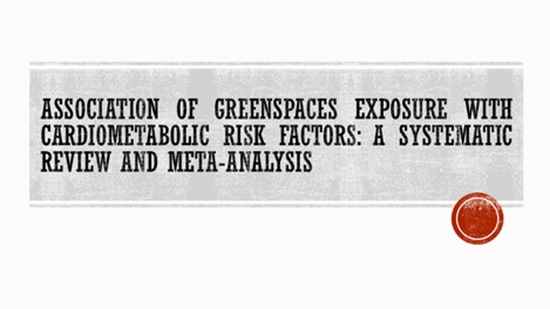Association of greenspaces exposure with cardiometabolic risk factors: a systematic review and meta-analysis
Cardiometabolic conditions are major contributors to the global burden of disease. An emerging body of evidence has associated access to and surrounding public open spaces (POS) and greenspace with cardiometabolic risk factors, including obesity, body mass index (BMI), hypertension (HTN), blood glucose (BG), and lipid profiles. This systematic review aimed to synthesize this evidence

Abstract
Background: Cardiometabolic conditions are major contributors to the global burden of disease. An emerging body of evidence has associated access to and surrounding public open spaces (POS) and greenspace with cardiometabolic risk factors, including obesity, body mass index (BMI), hypertension (HTN), blood glucose (BG), and lipid profiles. This systematic review aimed to synthesize this evidence.
Methods: This systematic review was conducted based on the PRISMA guidelines. Four electronic databases including Web of Science, PubMed, Scopus, and Google Scholar were searched for eligible articles published until July 2023. All observational studies which assessed the association of greenspace and POS with cardiometabolic risk factors including obesity, BMI, HTN, BG, and lipid profiles were included and reviewed by two authors independently. Heterogeneity between studies was assessed using the I2 index and Cochrane's Q test. Random/fixed effect meta-analyses were used to combine the association between greenspace exposure with cardiometabolic risk factors.
Results: Overall, 118 relevant articles were included in our review. The majority of the articles were conducted in North America or Europe. In qualitative synthesis, access or proximity to greenspaces or POS impacts BMI and blood pressure or HTN, BG, and lipid profiles via various mechanisms. According to the random effect meta-analysis, more access to greenspace was significantly associated with lower odds of HTN (odds ratio (OR): 0.81, 95% confidence intervals (CIs): 0.61-0.99), obesity (OR: 0.83, 95% CIs: 0.77-0.90), and diabetes (OR:0.79, 95% CI: 0.67,0.90).
Conclusions: Findings of this systematic review and meta-analysis suggested that greenspace accessibility is associated with some cardiometabolic risk factors. Improving greenspace accessibility could be considered as one of the main strategies to reduce cardiometabolic risk factors at population level.
Keywords: Blood pressure; Cardiometabolic; Greenspace; Hyperglycemia; Lipid profiles; Natural space; Parks; Urban environment.


_2.png)

ارسال نظر